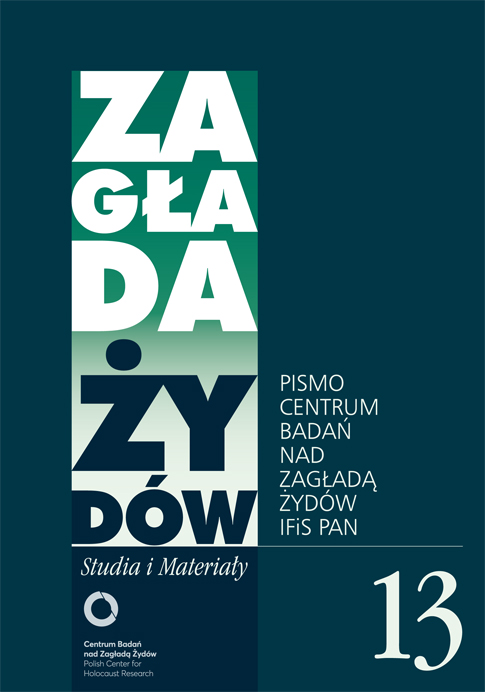Bernard Mark, powstanie w getcie warszawskim i proces Jürgena Stroopa
Zagłada Żydów. Studia i Materiały, Nr 13 (2017), Strony: 181-202
Data zgłoszenia: 2020-10-17Data publikacji: 2017-12-03
 https://doi.org/10.32927/ZZSiM.356
https://doi.org/10.32927/ZZSiM.356
Abstrakt
Jürgen Stroop, the SS general who led the liquidation of the Warsaw Ghetto and the suppression of the Warsaw Ghetto Uprising in April–May 1943, was convicted by a Polish court in 1951 and executed in 1952. Bernard (Ber) Mark (1908–1966), Holocaust historian and director of the Jewish Historical Institute in Warsaw, provided expert testimony for the prosecution at Stroop’s trial. Mark felt constrained to graft a communist-inflected narrative onto his account of the Warsaw Ghetto Uprising and to shoehorn it into his expert testimony in court and then into his interpretation of the trial for a Jewish audience. He did his best to give the Jewish Fighting Organization, which spearheaded the uprising, and its Jewish fighters their due at a time when expression of unvarnished appreciation for Jewish heroism was risky, even while he was paying overrated tribute to the communist underground for its assistance to the Jewish rebels during the uprising. But he always stopped short of the line between conformity to and defiance of the communist regime
Słowa kluczowe
Bernard Mark , Żydowski Instytut Historyczny , powstanie w getcie warszawskim , proces Jürgena Stroopa
Licencja
Prawa autorskie (c) 2017 Autor&"Zagłada Żydów. Studia i Materiały"

Utwór dostępny jest na licencji Creative Commons Uznanie autorstwa 4.0 Międzynarodowe.
https://creativecommons.org/licenses/by/4.0
Czasopismo publikowane jest w standardzie Diamond Open Access na licencji CC-BY-4.0 Deed - Uznanie autorstwa 4.0 Międzynarodowa - Creative Commons
Inne teksty tego samego autora
- Gabriel Finder, Proces Szepsla Rotholca a polityka kary w następstwie Zagłady , Zagłada Żydów. Studia i Materiały: Nr 2 (2006)
- Gabriel Finder, Svenja Bethke, Dance on the Razor’s Edge:Crime and Punishment in the Nazi Ghettos [Gabriel N. Finder] , Zagłada Żydów. Studia i Materiały: Nr 17 (2021)
Podobne artykuły
- Paweł Smoleński, Czy autor powinien być katonem? [Michał Wójcik, Zemsta] , Zagłada Żydów. Studia i Materiały: Nr 17 (2021)
- Klara Jackl, Czy to ja ... Pamiętnik obrazkowy Henryka Becka z czasu wojny i Zagłady , Zagłada Żydów. Studia i Materiały: Nr 20 (2024)
- Przemysław Czapliński, The Auschwitz Virus , Zagłada Żydów. Studia i Materiały: Nr Holocaust Studies and Materials (2017)
- David Engel, Adam Puławski, W obliczu zagłady. Rząd RP na Uchodźstwie, Delegatura Rządu RP na Kraj, ZWZ-AK wobec deportacji Żydów do obozów zagłady (1941–1942), Lublin: Instytut Pamięci Narodowej, Oddział w Lublinie, 2009, 583 s. , Zagłada Żydów. Studia i Materiały: Nr 7 (2011)
- Jacek Leociak, Adam Mazur, Artur Żmijewski, „Berek jest głosem o niemocy wobec okrucieństwa; pragnieniem, by Zagłada się nie wydarzyła”. Z Arturem Żmijewskim rozmawiają Jacek Leociak i Adam Mazur , Zagłada Żydów. Studia i Materiały: Nr 17 (2021)
- Ewa Cuber-Strutyńska, Witold Pilecki. Confronting the legend of the “volunteer to Auschwitz” , Zagłada Żydów. Studia i Materiały: Nr Holocaust Studies and Materials (2017)
- Adam Puławski, Zagłada Żydów na polskich terenach wcielonych do Rzeszy, red. Aleksandra Namysło, Instytut Pamięci Narodowej, Warszawa 2008 , Zagłada Żydów. Studia i Materiały: Nr 6 (2010)
- Jacek Leociak, Ruta Sakowska (1922–2011) , Zagłada Żydów. Studia i Materiały: Nr 7 (2011)
- Alina Skibinska, Joanna Tokarska-Bakir, „Barabasz” i Żydzi. Z historii oddziału AK „Wybranieccy” , Zagłada Żydów. Studia i Materiały: Nr 7 (2011)
- Barbara Engelking, Notes by Jan Górnicki (Ber Oszer Weisbaum) , Zagłada Żydów. Studia i Materiały: Nr Holocaust Studies and Materials (2013)
<< < 2 3 4 5 6 7 8 9 10 11 12 13 14 15 16 17 18 19 20 21 22 23 24 25 26 27 28 29 30 31 32 33 34 35 36 37 38 39 40 41 42 43 44 45 46 47 48 > >>
Możesz również Rozpocznij zaawansowane wyszukiwanie podobieństw dla tego artykułu.
 English
English
 Język Polski
Język Polski



 https://orcid.org/0000-0003-2829-3979
https://orcid.org/0000-0003-2829-3979

